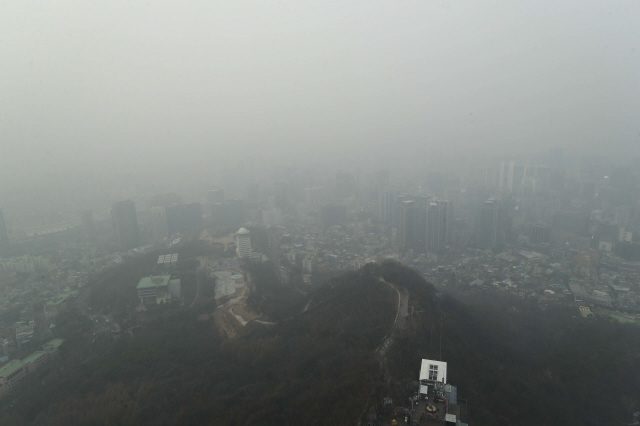 |
|
Seoul is blanketed by fine-particle pollution. (Hankyoreh archives)
|
Seoul conditions worsen around 12-30 hours after ultrafine dust rises in Chinese cities
The recent severity of fine particle pollution in Seoul is the result of worsening domestic meteorological conditions along with the arrival of ultrafine dust originating in Chinese cities such as Beijing and Shenyang, an analysis concludes. Some have also suggested fireworks set off in Beijing during Lunar New Year celebrations in late February have had an impact on atmospheric pollution in Seoul. “January and February ultrafine particle concentrations in Chinese cities were around 23% higher than for the same time period last year,” said Seoul Metropolitan Government Institute of Health and Environment (SIHE) Director Shin Yong-seung in a Mar. 6 briefing at Seoul City Hall. “At 37㎍/㎥, Seoul’s average ultrafine particle concentrations for January and February were the highest in the past five years, and the number of days classified as ‘poor’ for particle dust conditions increased substantially to 23,” he said. Shin went on to explain, “Wind speeds for the Seoul area in January and February of this year were at their lowest in five years, while the number of days with rainfall was also at its lowest in five years.” “The meteorological conditions were the worst possible, leading to the possibility of high concentrations of high particle dust,” he said. According to Shin’s explanation, the consecutive days of severe ultrafine particle pollution were the result of dust continuing to arrive from China and other countries amid stagnation in the atmosphere, with little wind or rain to scatter or wash away the fine dust. An SIHE analysis of changes in fine particle dust concentrations over time showed Seoul’s concentrations rising between 12 and 30 hours after the emergence of high concentrations in Beijing and Shenyang. Seoul’s sulfate concentrations rose by 4.6 times around 20 hours after firework celebrations during the Lantern Festival in Beijing on Feb. 19; strontium, a product of firework combustion, rose by 11.1 times. At noon on Mar. 2, fine particle dust concentrations in Beijing were recorded at 231㎍/㎥; 30 hours later, concentrations in Seoul were observed between 72 and 101㎍/㎥. On this basis, SIHE concluded that contaminants originating in China are likely to have had an impact on the greater Seoul metropolitan area. Necessity of reducing domestic gas emissions To reduce the amount of fine dust, the SIHE stressed the need for domestic efforts alongside the elimination of external factors. “We can’t just see this as a matter of meteorology and external factors and do nothing about it. We also need historic efforts to reduce domestic gas emissions,” Shin said. “If the various constraints are such that we can’t drastically reduce domestic emission factors in a short period of time, it’s a good idea to reduce sources that would have a substantial reduction effect in terms of health hazards,” he suggested. In particular, he noted that diesel exhaust gas is known to contain more carcinogens and other components harmful to health than other emissions sources. As a measure to reduce emissions domestically, the city of Seoul plans to institute ongoing restrictions on travel by older diesel vehicles (registered in 2005 and before) in its “green transportation promotion zone” (the Jongno and Jung [Central] district area inside of the city’s four main gates) as of the second half of this year. “We’re planning a phased expansion of the congestion fee system currently being used in the Namsan #1 and #3 Tunnels to reduce vehicle travel within the city center,” explained an official with the city’s transportation policy division. “The ongoing restrictions on older diesel vehicles within the green transportation promotion zone represents the first stage of that,” the official said. Once the plan has been implemented, older diesel vehicles will no longer be able to travel within designated regions of Seoul. The city currently implements this restriction only in cases of emergency fine particle reduction measures. At the same time, the city said it has no plans for now to expand the regulations currently restricting car travel by public employees when emergency reduction measures are in effect. “The system hasn’t been in place for very long and some time will be needed before it becomes established, so we’re not yet considering additional measures related to vehicle restrictions,” said Gu A-mi, the city’s atmospheric planning officer. “Things like regulations on car travel by public employees will be decided in consultation with the central government after listening closely to what citizens have to say,” Gu added. By Kim Mi-hyang, staff reporter Please direct comments or questions to [english@hani.co.kr]






